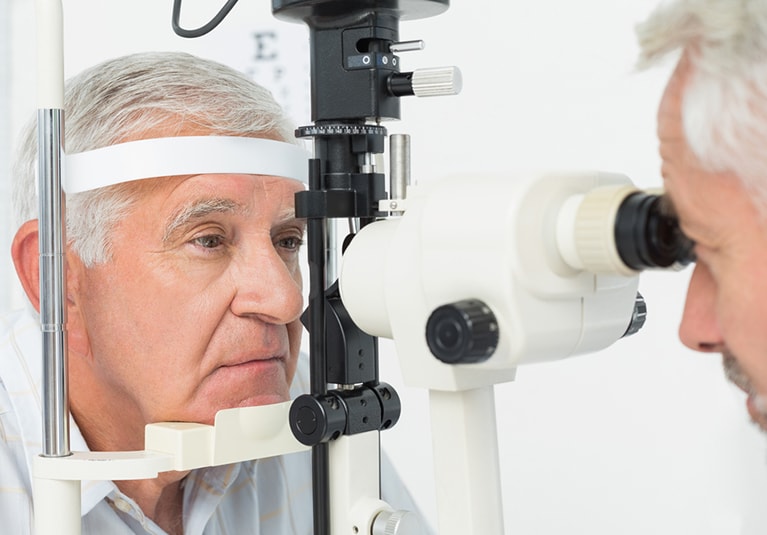How Does Mao Clinic Do Macular Hole Repair Without Face Down
Sept. 05, 2012

A retrospective study of 68 eyes (65 patients) indicates that macular hole surgery with broad internal limiting membrane (ILM) peeling, 20 percent sulfur hexafluoride (SF6) gas and no face-down positioning is highly effective in the surgical treatment of idiopathic macular holes. The method also eliminates the morbidity associated with postoperative face-down positioning.
Currently, most surgeons employ face-down positioning for variable periods following macular hole repair surgery. "This may place a significant burden on patients and even eliminates the surgical opportunity for some," says Raymond Iezzi Jr., M.D., with the Department of Ophthalmology at Mayo Clinic in Rochester, Minn. "Macular hole closure using limited face-down posturing has been reported previously with varying rates of success."
Dr. Iezzi's team reviewed all idiopathic macular hole surgeries he performed at Mayo Clinic between March 2009 and December 2012. Broad ILM peeling, 20 percent SF6 gas and no face-down positioning were employed in all of the surgeries.
Of the 68 eyes studied, 48 were in women and 20 were in men. Their average age was 69 years. Characteristics include:
- 3 patients had bilateral macular holes, and 9 were referred to Mayo for treatment of their recurrent macular holes.
- 21 eyes had stage 2, 27 had stage 3, and 20 had stage 4 macular holes.
- At the time of surgery, 24 eyes were pseudophakic and 44 eyes were phakic.
- A posterior vitreous detachment was present in 20 eyes before surgery.
Patient outcomes
"We considered the single-procedure macular hole closure rate, the mean postoperative best corrected visual acuity, the incidence of cataract and intraocular pressure to compare this surgical treatment with methods that use longer acting gas endotamponade, face-down positioning or both," says Dr. Iezzi. In this study, all eyes completed one-month follow-up and 61 of 68 eyes completed the three-month follow-up.
Findings, published online in the journal Ophthalmology in July 2013, include:
- The single-procedure macular hole closure rate was 100 percent (95 percent confidence interval was 95 to 100 percent) as observed by optical coherence tomography. No complications were observed.
- Overall, 56 of 68 eyes achieved best corrected visual acuity (BCVA) of 20/50 or better at last follow-up. Of the 61 eyes that completed at least three months' follow-up, 53 eyes achieved 20/50 BCVA or better.
- There were no cases of gas bubble-induced cataract that required prompt cataract surgery. The mean interval from macular hole repair to cataract surgery was 207 days. Over a mean follow-up of 216 days, 79 percent of phakic eyes eventually proceeded to cataract surgery. The incidence of postoperative retinal detachment or macular hole reopening was 0 percent.
- Mean postoperative intraocular pressure (IOP) was 15 mm Hg and 16 mm Hg on postoperative days one, seven and 30, respectively, and did not differ significantly from the mean preoperative IOP of 16 mm Hg.
"Face-down positioning reduces the anterior displacement of the lens-iris diaphragm that often elevates IOP in the presence of gas endotamponade," says Dr. Iezzi. "We needed to demonstrate that our no-face-down approach did not increase IOP."
Older patients benefit
Idiopathic macular holes occur almost exclusively in older patients, who are least able to maintain face-down positioning requirements because of increased incidence of cervical and lower back ailments.
"Closure methods that eliminate the need for face-down positioning and do not compromise closure rates would reduce patient morbidity significantly, improve patient satisfaction and represent a significant advancement in surgery for macular holes," says Dr. Iezzi. "Although this retrospective study has limitations, our data suggest that by using broad ILM peeling, 20 percent SF6 gas and no face-down positioning, macular hole closure rates are comparable with or better than those of other closure methods."
For more information
Iezzi R, et al. No face-down positioning and broad internal limiting membrane peeling in the surgical repair of idiopathic macular holes. Ophthalmology. 2013;120:1998.
Contact Raymond Iezzi Jr., M.D., at iezzi.raymond@mayo.edu or 507-284-4152.
How Does Mao Clinic Do Macular Hole Repair Without Face Down
Source: https://www.mayoclinic.org/medical-professionals/ophthalmology/news/macular-hole-repair-does-not-require-face-down-positioning/mac-20430610
Posted by: graymomse2000.blogspot.com

0 Response to "How Does Mao Clinic Do Macular Hole Repair Without Face Down"
Post a Comment